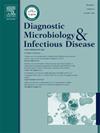肺炎克雷伯菌感染社区获得性肺炎的临床特点及死亡危险因素分析。
IF 2.1
4区 医学
Q3 INFECTIOUS DISEASES
Diagnostic microbiology and infectious disease
Pub Date : 2024-12-16
DOI:10.1016/j.diagmicrobio.2024.116660
引用次数: 0
摘要
由肺炎克雷伯菌(KP)引起的社区获得性肺炎(CAP)导致高死亡率。本研究纳入121例由高毒力或耐药KP菌株引起的CAP患者的特点及危险因素,这在以往的研究中报道较少。我们发现,高毒力KP和产生esblp的KP感染都不会影响死亡率(P < 0.05),而qSOFA评分升高(比值比[OR] 4.50, 95%可信区间[CI] 1.55-12.76, P = 0.005)和APACHE-II评分升高(比值比[OR] 1.30, 95% CI 1.13-1.48, P < 0.001)是死亡率的独立危险因素。此外,qSOFA预测所有患者、ICU患者和非ICU患者死亡率的曲线下面积(auc)分别为0.82、0.74和0.81。qSOFA或APACHE-II评分升高被认为是28天死亡率的独立危险因素。qSOFA评分可以很好地预测KP CAP患者的死亡率。本文章由计算机程序翻译,如有差异,请以英文原文为准。
Analysis of clinical characteristics and mortality risk factors in patients with community-acquired pneumonia caused by Klebsiella pneumoniae
Community-acquired pneumonia (CAP) caused by Klebsiella pneumoniae (KP) results in high mortality. 121 cases were included in this study to explore the characteristics and risk factors of CAP patients caused by hypervirulent or resistant KP strains, which were limited reported in previous studies. We found that neither hypervirulent KP nor ESBL-producing KP infections affect mortality (P > 0.05), while increased qSOFA score (odds ratio [OR] 4.50, 95% confidence interval [CI] 1.55–12.76, P = 0.005) and APACHE-II score (OR 1.30, 95% CI 1.13–1.48, P < 0.001) were independent risk factors for mortality. In addition, the areas under the curve (AUCs) of qSOFA in predicting the mortality rate of all patients, ICU patients, and non-ICU patients were 0.82, 0.74, and 0.81, respectively. Elevated qSOFA or APACHE-II scores were considered independent risk factors for 28-day mortality. The qSOFA score was a good predictor of mortality among KP CAP patients.
求助全文
通过发布文献求助,成功后即可免费获取论文全文。
去求助
来源期刊
CiteScore
5.30
自引率
3.40%
发文量
149
审稿时长
56 days
期刊介绍:
Diagnostic Microbiology and Infectious Disease keeps you informed of the latest developments in clinical microbiology and the diagnosis and treatment of infectious diseases. Packed with rigorously peer-reviewed articles and studies in bacteriology, immunology, immunoserology, infectious diseases, mycology, parasitology, and virology, the journal examines new procedures, unusual cases, controversial issues, and important new literature. Diagnostic Microbiology and Infectious Disease distinguished independent editorial board, consisting of experts from many medical specialties, ensures you extensive and authoritative coverage.

 求助内容:
求助内容: 应助结果提醒方式:
应助结果提醒方式:


